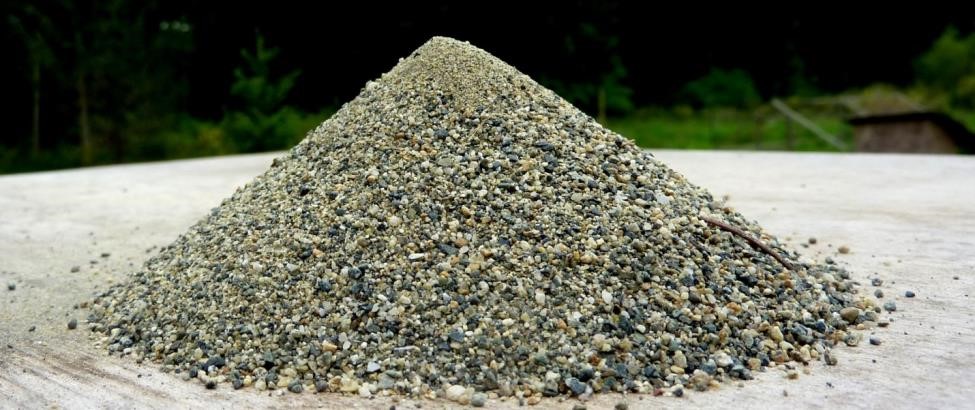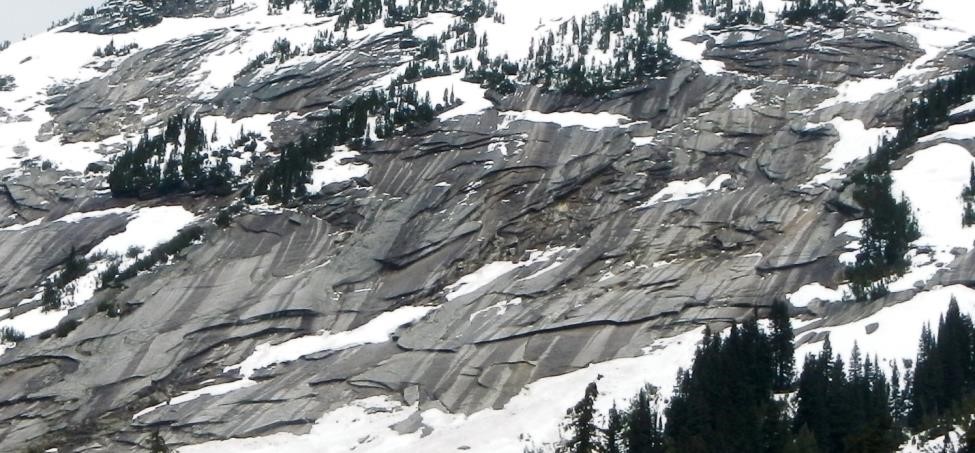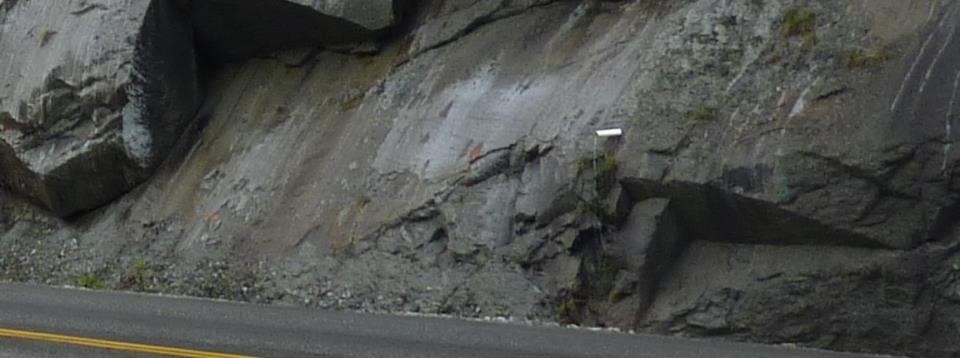Table of Contents
4-3 Mass Wasting
Read Chapter 15 in Physical Geology.
Chapter 15 describes mass wasting as the gravity-related failure of material on slopes created by tectonic forces. Be sure to read the introductory section on what we can learn from past failures, such as the 1965 Hope Slide.
In Section 15.1, we look at the various factors that control mass wasting, including those that lead to slopes being unstable, and those that trigger specific mass-wasting events. One of the key issues is slope, because, as no one needs to be told, the steeper the slope is, the more likely that parts of it will fail. The physics behind this is illustrated in Figure 15.1.1. As steepness increases, the component of the gravitational force that is pushing material down the slope becomes greater. Where that force, known as sheer stress, exceeds the strength of the material, failure is possible.
Therefore, the strength of materials on slopes is the other critical variable in slope failure, and that strength can vary for a number of reasons. The first factor is the overall strength of the material—whereas rocks like granite are extremely strong (and can form vertical slopes without failing), other rocks such as sandstone or mudstone are much less strong. Unconsolidated materials, such as glacial sediments, are even weaker because there is little to hold the particles together. Dry sand or gravel (or even cobbles or boulders) can only sustain a stable slope of around 30˚, as illustrated in Figure 4-9.

Rock that is fractured or that includes bedding planes or metamorphic foliation is more prone to failure than solid rock, and this is especially true if the fractures or planes of weakness are parallel to the slope (Figure 15.1.2). This potential for failure is also illustrated in Figure 15.0.1 and Figure 4-10.

Finally, water content plays an extremely important role in the strength of materials on slopes. With respect to unconsolidated sediments, a small amount of water—enough to coat the grains, for example—will have a cohesive effect that makes the material stronger than when it is dry. A large amount of water will push the grains apart, making the material weaker than when it is dry.
You can see this effect for yourself by completing Exercise 15.1.
Sediment with clay minerals is especially affected by water because these minerals can absorb water, which causes them to swell and weaken the material, thus facilitating failure.
Even the strength of rock is affected by the presence of water. As water under pressure fills fractures or bedding planes, it pushes the rock apart very slightly, which reduces friction along these planes and contributes to failure. That’s why you’ll see drainage pipes sticking out of solid rock along some highway road-cuts, as shown in Figure 4-11. In such cases, holes are drilled for many metres into the rock to give water from fractures and bedding planes an opportunity to drain out.

Slopes can remain in a semi-stable state without failing for years or decades until some event triggers a sudden failure. As noted in the textbook, such triggers typically involve a weakening of the material, and the most common trigger is heavy rainfall that saturates and dramatically weakens unconsolidated material or even solid rock. In the example shown in Figure 15.1.6, heavy rainfall was a factor, but a disturbance to the drainage process related to roads, buildings, and landscaping in that built-up part of North Vancouver also contributed. Earthquakes also are common triggers of mass wasting because they shake and weaken geological materials.
The classification of mass wasting is summarized in Section 15.2. As noted, the key criterion for classification is the nature of the movement, which can be fall—if an object (such as a piece of rock) falls nearly vertically through the air; slide—if a body of material moves downslope as a single unit; and flow—if a mass of unconsolidated material or broken rock flows down a slope in a fluid manner. Of course, it’s not always possible to know how something is moving, and it’s also quite common for more than one type of motion to occur during one event.
The classification of seven important types of mass wasting is summarized in Table 15.1. To familiarize yourself with these types, and the nature of their motion, complete the following exercise.
Seven types of mass wasting are listed below. Print out the page and write each one in the most appropriate circle describing the type of motion.
| Slump | Fall | Slide | Flow |
| Creep |  |  |  |
| Rock fall | |||
| Debris flow | |||
| Rock avalanche | |||
| Mud flow | |||
| Rock slide |
Please read carefully through the descriptions of the different types of slope failures in the rest of Section 15.2, and then complete Exercise 15.2, which should assist you in your understanding of the classification of slope failure.
The mitigation of risks associated with mass wasting is discussed in Section 15.3. It’s important to be clear from the outset that while we can delay some types of slope failure, for many years or even many decades, we cannot prevent it from happening.
Erosion is inevitable and, in the long run, the efforts of humans are insignificant. Even more important than trying to prevent mass wasting from occurring is to not make things worse through poorly planned construction, and to understand the mass wasting processes well enough to identify places that we should avoid.
As noted, road construction has a huge impact on slope stability, first because our road networks are so extensive, second because roads commonly have to cross difficult terrain, and third because roads require the creation of flat surfaces. Roads built along steep slopes inevitably make part of that slope steeper than it was, which increases the sheer stress and the risk of failure. Perhaps even more important, however, is that road construction interrupts drainage on slopes, and that can lead to slope failure.
The construction of buildings and other structures also contributes to mass wasting, but not necessarily for the reason you might think.
Please complete Exercise 15.3, which deals with the effect of a building’s weight on slope stability as well as its effects on drainage.
In many cases, slope instability is recognized long before any significant threat of catastrophic failure, which gives us an opportunity to monitor a slope for any signs of change in its stability. The Downie Slide (Figure 15.2.3 and related text) is monitored this way. If there is any evidence that its behaviour is changing, steps can be taken to reduce the risks downstream in places like Revelstoke. The lahar risk around Washington’s Mt. Rainier is monitored in different ways, but in this case, the warning time is measured in minutes instead of weeks or months.
In areas where we know that slope failures are inevitable, we can take steps to minimize risk. For example, the village of Lions Bay north of Vancouver is located on an alluvial fan, which is the only area flat enough to build houses in that part of a glacial U-shaped valley. At the same time, however, it also is the worst possible place to build houses because the alluvial fan was created by hundreds of past debris flows. By the time the seriousness of the risk was recognized, dozens of expensive homes, a major highway, and a railway were sitting in harm’s way. Instead of moving everything, a decision was made to mitigate the risks by building containment structures, as illustrated in Figure 15.3.6.
Whenever possible, we should avoid the expensive measures of trying to prevent or delay mass wasting, or mitigate its effects as has been done in the Lions Bay area, and instead keep infrastructure and people out of the way. An example of this avoidance strategy in the Garibaldi area in BC is provided at the end of Section 15.3.
Please answer the review questions at the end of Chapter 15.
This completes the notes for Unit 4.
Note if you are a registered student: If you haven’t already done so, now is the time to start working on Assignment 4 (go to the “Assignments Overview” area of your course). You should find most of what you need to complete the assignment within these course notes and Chapters 13 to 16 of your textbook, but you might also need to refer to other sources of information.
There is one unit left in this course, so—if you’re a registered student—now might be a good time to start thinking about scheduling your final exam.


